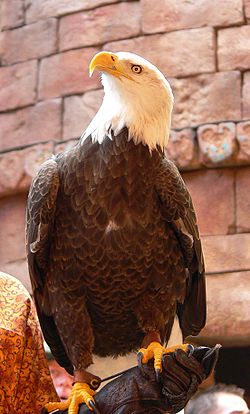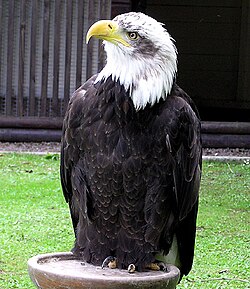Field Guide/Birds/Haliaeetus leucocephalus
The Bald Eagle (Haliaeetus leucocephalus) is a bird of prey indigenous to North America, most recognizable as the national bird of the United States. The species was on the brink of extinction late in the 20th century but has largely recovered and now has a stable population and is no longer on the U.S. federal government's list of endangered species.
The bird gets both its common and scientific names from the distinctive appearance of the adult's head. Bald in the English name refers to the white head feathers, and the scientific name is derived from Haliaeetus, the New Latin for "sea eagle," (from the Greek haliaetos) and leucocephalus, the Greek for "white head," from leukos ("white") and kephale ("head").
Range and habitat
Bald Eagles can be found in small concentrations throughout the U.S. and Canada, particularly near large bodies of water. The state with the largest resident population is Alaska; out of the estimated 100,000 Bald Eagles on Earth, half live in Alaska.
Description
An immature bird has speckled brown feathers all over, the distinctive head and body plumage arriving 2–3 years later, before sexual maturity. Adult females have a wingspan of approximately 2.1 meters (7 feet); adult males have a wingspan of 2 meters (6 feet, 6 inches). Adult females weigh approximately 5.8 kg (12.8 lb), males weigh 4.1 kg (9 lb).
They are protected by three federal laws. The eagle law which protects bald and golden eagles, the migratory bird act, and the endangered species act.
Behavior
Bald Eagles build huge nest platforms out of branches, usually in large trees. Pairs, who mate for life, add material to the nest each breeding season. After several years, the nest may weigh upwards of a thousand pounds or more.
Bald Eagles which are old enough to nest often return to the area in which they were raised. They are more social than many other raptor species: an adult bald eagle looking for a nesting site is more likely to select a location that contains other immature eagles than one with no eagle population.
Bald Eagles are powerful fliers, and ride thermal convection currents to range far.
They have a long lifespan, with reports of birds in captivity living to be 60 years old.
They do not scream as often shown on television. Usually the call of a red-tailed hawk is placed over the image of a flying eagle. They sqeak and have a shrill cry, punctuated by grunts.
Reproduction

Bald Eagles are sexually mature at 4 or 5 years of age. Mated pairs produce between one and three eggs per year, but it is rare for all three chicks to successfully fledge. Third chicks are sometimes removed from nests to use in reintroduction programs in areas where the species has died out.
In such programs, the birds are raised in boxes, on platforms in the tree canopy, and fed in such a way that they cannot see the person supplying their food, until they are old enough to fly and find their own food.
Diet
The Bald Eagle's diet is varied, including carrion, fish, smaller birds, rodents, and sometimes food scavenged or stolen from campsites and picnics. To hunt, the eagle swoops down over the water and snatches the fish out of the water with its claws. They eat by holding the fish in one claw and tearing the flesh with the other. Eagles have structures on their toes called spiricules that allow them to grasp fish. osprey also have this adaptation.
Sometimes, if the fish is too heavy, the eagle will be dragged into the water. It may swim to safety, but some eagles drown or succumb to hypothermia.
Rare vagrant
This species has occurred as a vagrant once in Ireland. The exhausted specimen was discovered by a national parks worker in a northern heath. Presumably, a storm blew it out to sea, and the bird struggled across the Atlantic Ocean.
National Bird of the US
The Bald Eagle is the national bird of the United States of America. When the United States was being established, Benjamin Franklin, one of the founding fathers and a signer of the Declaration of Independence, wished the national bird to be the Wild Turkey. Franklin believed the turkey was a good choice as it provided food for the early settlers and had a noble appearance. However, he was outvoted by the other members of the Continental Congress who felt that the eagle symbolized strength and alertness and that it would look much better as a national symbol.
Gallery
- Bald-eagle.jpg
Adult resting
- Bald Eaglehead.jpg
External links
- 11.9" x 8" 1.24 MB Bald Eagle JPEG provided by the U.S. Fish & Wildlife Service
da:Hvidhovedet havørn
de:Weißkopfseeadler
eo:Blankkapa maraglo
fr:Pygargue à tête blanche
nl:Amerikaanse zeearend
ja:ハクトウワシ
pl:Bielik amerykański
pt:Águia de cabeça branca
fi:Valkopäämerikotka
sv:Vithövdad havsörn



